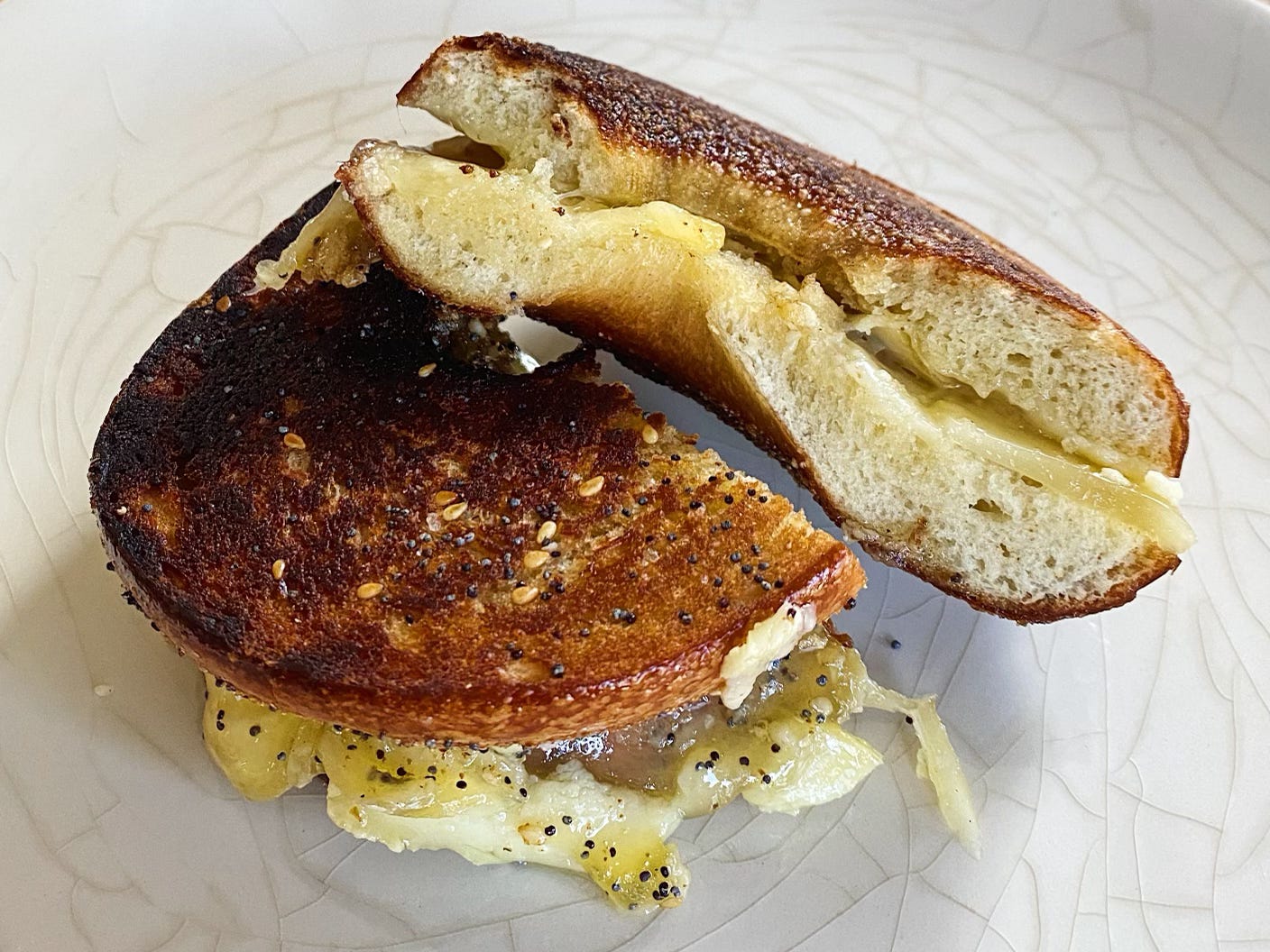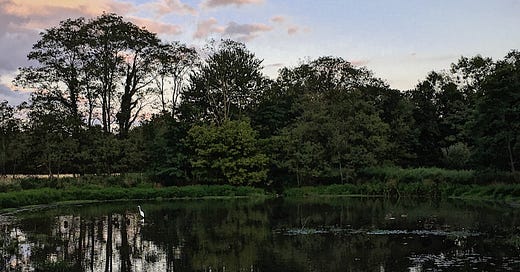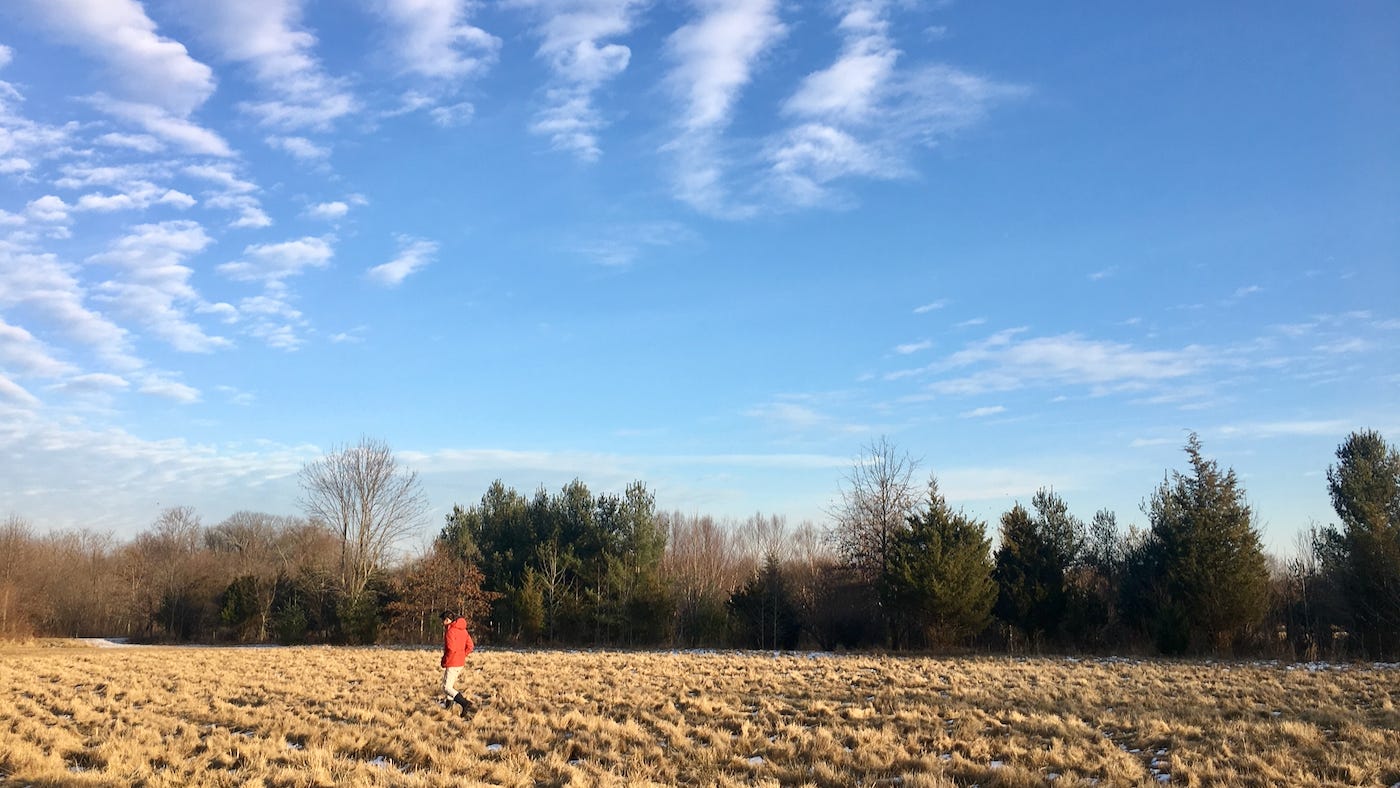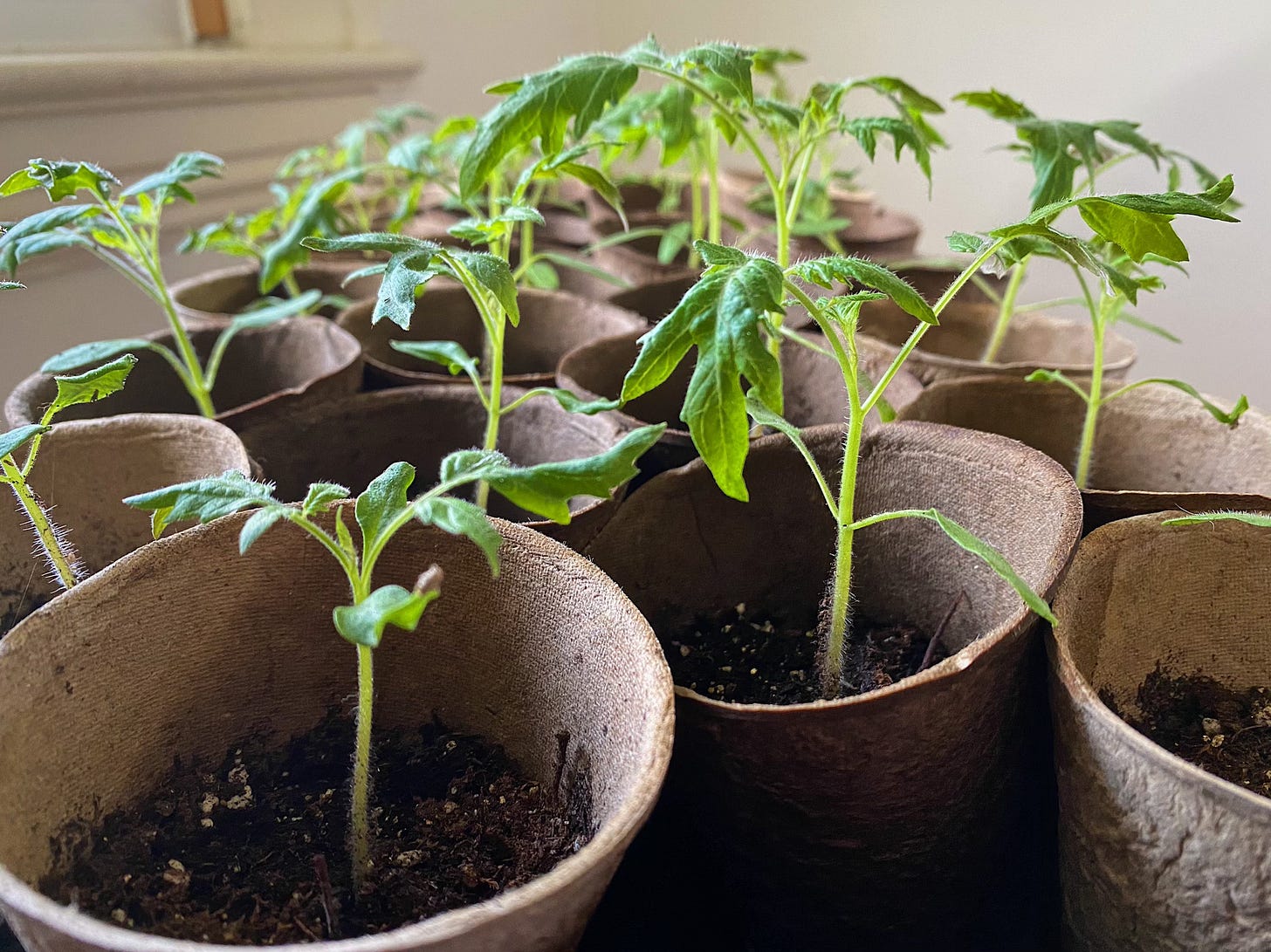Conversations with the Killdeer
Some fragmented thoughts on the power of silence, the joyous shouts of creation, excellent bagels, and the almighty McDonald's Filet-O-Fish
Thursday, April 22
Grand Rapids, Michigan
Greetings, dear reader.
Today is Earth Day. Question: Why does the planet get one day of attention out of 365? I suppose it’s a sad testament to the reality that every other day is Human Day.
I could go on an extended rant about this, but that would be boring, even to me. Instead, I’d like to share an essay I wrote as part of my thesis about the Farminary. It feels right for this moment in our nation and in our world.
For those of you who have somehow managed to escape my fanboy gushing about the Farminary: It’s a 21-acre sustainable farm that doubles as a classroom at Princeton Seminary. It’s one of my favorite spots in the whole world; I long for the day when I can once again wander out to the edge of the pond and spend some time watching the elegant heron who struts slowly through the shallows—the heron who never wants anything to do with me. It’s also the place that was hospitable enough, gracious enough, to welcome a hapless urbanite who had managed to kill even mint and turn him into a farmhand.
This story is called “Killdeer.” I hope you enjoy it.
Killdeer
One spring day, I spotted a killdeer sprinting across the gravel of the farm’s parking area.
You’d be overly generous if you thought I knew it was a killdeer at first. I didn’t. With its spindly legs, it did seem like a shorebird. I’ve spent enough time at the beach on Cape Cod to know what a piping plover looks like, because every year, swaths of sand are fenced off to protect their vulnerable breeding grounds. Watching the killdeer propel itself across the gravel reminded me of the quick-footed plovers. But that’s all I knew.
I downloaded an Audubon bird-identification app and answered the prompts until it gave me a few pictures to pick from. That’s how I figured out what it was. That’s also how I learned that, while killdeer are typically thought of as shorebirds, they are also skilled foragers that enjoy the insects found in the fields of healthy farms. They eat earthworms and other bugs. They don’t particularly mind humans either.
There was something charming to me about the efficiency of the killdeer’s movements. It seemed to be simultaneously super-quick and easygoing. To watch it make its way across the gravel of our parking lot was to observe a creature that seemed to be in full sprint while retaining the casual, effortless air of someone out for a gentle stroll.
I began to keep watch for the killdeer.
One afternoon, I was at the farm by myself to do some weeding. I was walked toward the garden when I noticed a killdeer standing by the garden gate, as if waiting to be let in. I stopped and pulled my phone out, trying to find the bird app as quickly as I could. The app has a collection of bird calls, and I started playing them as loudly as I could. To my amazement, the killdeer began to respond. Every time there was even the briefest of silences from my phone, the bird would fill it with its own call.
We went back and forth for a good twenty, twenty-five minutes. I appreciated its attentiveness, its willingness just to engage with me. But eventually, it seemed to get bored. I certainly don’t blame it, since I was just playing the same five calls on repeat.
The killdeer wandered off to do its thing, and only then did I wonder what I might have been saying to the killdeer this whole time. Was I seducing it? It didn’t seem like I was warning it of any danger, because I imagine it would have run off far more quickly. Did it regard me as some idiot who just kept repeating himself? Even worse: Was I making promises I couldn’t keep?
—
I think of silence a lot when I’m at the farm. Silence is such an interesting concept, because whenever we talk about it, we’re actually referring mainly to our choice to shut up.
There is really no such thing as silence, and nowhere am I reminded of this more than the farm. It’s an incredibly loud place.
While the humans might not be speaking, the other creatures that call this place home, whether temporarily or permanently, are never silent. The geese constantly honk in conversation with each other. Listen for the deer pushing their way through the woods, branches cracking underfoot. In the barn, you can often hear a mouse scuttling along the beams, the pitter-patter of its feet coming in rapid bursts.
If the wind is blowing, the branches of the trees clap. If rain has just come through, you can hear a slight crackle as the soil sucks the water up—and if it’s been a big storm, there’s a steady whoosh; what can’t be absorbed follows the guidance of the terrain, making its way toward the stream and onward to the pond.
My favorite sound at the farm is the burble of that stream. I like to sit on the stone bridge and listen to the water’s progress. Gravity gently urges the water down toward the pond, and there’s a subtle but constant slap against the rocks that reside within the water’s path. The stream never, ever stops moving. It is never, ever silent.
I wonder sometimes what life must be like for the aquatic plants that live their lives holding on unceasingly against this current. You can see them just below the surface of the clear waters—these little green hangers-on that lean constantly in one direction. To me, they look as if they spend their entire lives sideways. But that’s my perspective. Does the world above the surface look sideways to them?
It’s never a bad thing to consider one’s perspective—the framing, the assumptions, that underlie a question. For instance, when I think about the Farminary’s loudness, I also wonder about what we perceive to be God’s silence. Many of us have accused God of being silent, especially in tender moments and painful seasons. Some have argued that God is never silent—only failing to speak in a timbre that we can register. C.S. Lewis wrote in “The Problem of Pain” that “God whispers to us in our pleasures… but shouts in our pains: It is His megaphone to rouse a deaf world.”
That God seems to me a cruel, even sadistic God. It implies that our pain is God’s intended tool. But it takes an immense amount of privilege to say this about others’ suffering. I reject it. It’s totally incompatible with my understanding of a loving, nonviolent God.
That isn’t to say that God can’t accompany us through pain and suffering; indeed I believe God does. In dire circumstances, we can find ourselves hearing God in new and different ways, because of our acute awareness of our vulnerability as well as our need for salvation. We can’t afford the pretense of independence—or maybe we just don’t have the energy for it. We quiet ourselves because there might be nothing left to say. We’ve prayed all the prayers we know how to pray. We have no more words.
Nor are all silences equal. There is, for instance, the tragically common silence that’s imposed upon others, especially those who are seen as “less than” and whose voices are heard as “less than.” In her short essay “The Transformation of Silence into Language and Action,” Audre Lorde writes movingly about such silence—and the power of resisting it and breaking it. As a black, lesbian writer, to claim space through her spoken and written words, to choose not to be silent—such acts took tremendous courage. Lorde urges others who are dealing with similar dynamics to confront their fear, to recognize the costs of not speaking out, to understand how their voices have been suppressed to the point of death. She exhorts them not to be silent.
The kind of silence that Lorde writes about isn’t the kind of silence I am talking about, which is rooted in our willingness to be silent. The silence I am talking about is the kind that you and I already have the power—and perhaps the privilege—to control. It’s the free exercise of the choice not to talk, the choice to listen. It’s the subordination of our desire to speak and be heard to the calling not to speak but to hear.
In making this choice, in surrendering to this call, I wonder whether it is not in fact God who changes but the hearers. Isn’t there something anthrocentric about thinking that it is God who must shift God’s communication methods rather than we who must recalibrate how we hear? I wonder whether the love and the mercy, the beautiful whispers and the jarring shouts, register as such because our ears undergo training; they learn to recognize.
Another thing that I don’t entirely understand in C.S. Lewis’s framing: I can find no evidence of a deity who whispers to us in our pleasures. On the farm, at least, the delights mount up in glorious and raucous chorus. They shout.
John Calvin famously wrote about the ways in which the created world proclaims God’s glory. While he resorts mostly to imagery of sight and vision, in the Institutes he also occasionally deploys sound. “It were, indeed, a strange defense for man to pretend that he has no ears to hear the truth” of God and God’s presence, he writes, “while dumb creatures have voices loud enough to declare it.” (Calvin, like Thomas Aquinas before him, vastly underestimates the ability of non-human animals to communicate and to reason.) He explains that we ought to gain something from “that bare and simple, but magnificent testimony which the creatures bear to the glory of their Creator.” Yet we fail to give it our full attention, such that “we either so obscure or pervert [God’s] daily works, as at once to rob them of they glory and the author of them of his just praise.”
This land is beginning to tell me, through its interactions with sky and seed, cloud and creatures, that it has its way of doing things, and it is not a quiet way at all. What good is muted praise? I never really understood this before, probably because I never knew how to listen.
—
The killdeer came and went for some weeks. Often I would stop and talk to it through the app, still not knowing what I was saying but insisting on trying to make the connection anyway. If it had time and nothing better to do, it would humor me for a few minutes. Other times, it wouldn’t.
Killdeer are adaptable, adjusting their habits and lives to human encroachment remarkably well. One day, we found four killdeer eggs in a nest of sand and gravel at the edge of the parking area. Not long after, the eggs were gone. We didn’t know whether they had hatched (unlikely) or whether they had been crushed by an unknowing car (no evidence) or whether they had become a meal for some egg-loving predator (most probably)—maybe one of the foxes that lives nearby?
It’s interesting that I assumed it was the same bird the whole time—yet another way in which I imposed my desired narrative on a story that was probably messier than I wanted to believe. I don’t really know. My life may have intersected with that of a killdeer (or several) for a short season, and I might try to fill in the silences with my speculation. But not all stories are ours to tell.
What I’m Growing: The tomatoes seem to be doing okay—and if I remember correctly, they’re much more robust than last year’s. I’ve transferred most of them to 3” peat pots to give them more room to grow. The bok choy, lettuce, and spinach that I planted outside seems to have survived the freeze from the past couple of nights without much difficulty. My lemon balm, though, is struggling, and I’m not sure what I did wrong. The seeds germinated, but all of the tiny plants have stalled out after putting out just a couple of leaves. And none of the milkweed seeds that my friend Annie sent have done a thing. Keeps me humble.
What I’m Cooking: A bagel shop opened up walking distance from our house last year. It shattered my cheap Chinese heart to pay $7.50 for a bacon, egg, and cheese on a toasted everything—$2 more than I ever paid in Brooklyn. The bagel was okay. Then, after friends in New York sent us bagels and lox from H&H, Angela Ochoa, the proprietor of The Cottage Bagel and an Evolving Faith Podcast listener, reached out to say that she makes small-batch bagels here in GR. Last weekend, we got to try some.
When I picked them up on Saturday, Tristan and I had already eaten breakfast, so we made grilled-cheese sandwiches for lunch—one on a plain bagel, one on an everything. The everything is my favorite bagel. The challenge with making a grilled cheese with an everything bagel is the potentially devastating loss of much of that “everything” goodness on the outside. Fortunately, Google summoned a recipe from Sadelle’s, a bagel shop/restaurant in New York, where they make an inverted bagel grilled cheese. By flipping the sliced bagel inside out before grilling it, you get the cheese (I used brie and raclette, because that’s what we had in the fridge) to melt into harmony with the everything spices. A genius technique.

The next morning, we tried Angela’s bagels toasted with cream cheese. An excellent bagel harmonizes textures—near-crisp and crusty on the outside, pleasantly chewy on the inside—and I am delighted to report that these were very, very good. If you live in GR, I commend them to you, and if you just like looking at pictures of bagels, you can follow her on Instagram at @thecottagebagel.
What I’m Reading: I have no shame about my food tastes, which can run very high and very low. I’ve written before about my love for McDonald’s hash browns. I also delight in an occasional Filet-O-Fish. The culture critic and film scholar Jane Hu has a lovely piece in the New York Times Magazine about this sandwich. It brought back memories of my walks with my grandmother to our local McDonalds in Berkeley, California, at the corner of Shattuck and University. My grandma would order me a Filet-O-Fish (“Filet fishuuu,” she would say) and get herself a cup of coffee—free for senior citizens!—which she’d sip slowly while I ate my sandwich. After reading Hu’s essay, I got myself a Filet-O-Fish. It was haphazardly thrown together—and just as delightfully disappointing as she says.
I’m curious: What did my reflections on the killdeer and on silence stir up in you? And what junk foods give you guilty pleasure and inexplicable delight? I’d love to know.
That’s all I’ve got for you this week. As always, I’m so grateful we can stumble through all this together, and I’ll try to write again soon.
Yours,
Jeff








I was struck by what you said about CS Lewis saying God whispers in our pleasures and shouts in our pain. I would not have thought of a reaction like you had, of thinking it made God sound cruel. I see how it could strike someone that way and that interpretation makes sense. I take it to mean more like what we read about the "still small voice" Elijah heard. Elijah heard God's voice as a whisper, it seems to me, because he heard it in quietness, where the voice does not have to be loud in order for us to hear it. I think God was present in all the loud things that the passage mentions, too, but the big point was that we need to listen for and hear God's voice in the quiet. I take what Lewis said to mean that in pleasure we hear God's voice as a whisper because that is a quiet time, and in pain we might hear God's voice as a shout because we are hearing it above the noise (so to speak) of the pain. At different times we hear God's voice in different ways. We hear it in the burble of a stream, as you describe, and we also hear it in the clap of branches in the wind or the crash of thunder. I think "hearing" is a recognition of the presence of God in everything, not as God actually using things like pleasure or pain as potentially cruel tools to force us to listen.
I'm a birder who is grateful for this way of connecting to the creator. Beyond the analysis of bird ID & reporting my sightings or hearings to eBird, there's the part that's deeper. I explore the natural world on the theory that every creature is somehow an expression of creator's love, that creation & re-creation is love in action. When I dwell on it, it is truly stunning. Thank you for your words!